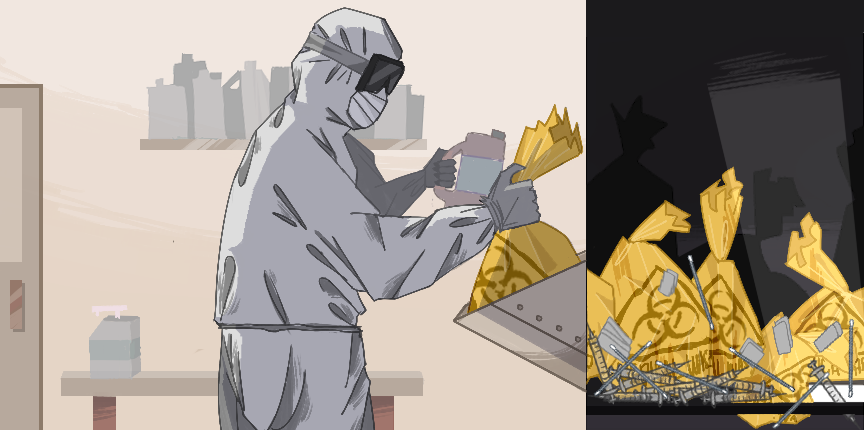AN ESTIMATED 280 metric tons of healthcare waste per day was produced in Manila alone last April 2020, according to the Asian Development Bank. This starkly exceeded their pre-pandemic estimation report, which stated that hospitals would generate approximately 47 metric tons of medical waste per day. In addition to the high waste volume, data on healthcare waste showed that approximately two billion face masks were used in Asia alone.
Hospitals across the globe have formulated guidelines to lessen the volume of waste. However, it is quickly becoming clear that the responsibility does not fall solely on their shoulders. According to the United Nations Environment Programme’s research, countries must take a multi-sectoral approach in dealing with the COVID-19 waste issue.
Action-Reaction
The accumulation of healthcare waste was first considered inevitable by the Department of Health (DOH) in the COVID-19 pandemic’s early stages. However, according to Plastics in Healthcare Project Officer Raphael Lopez, the waste management policies put into place by hospitals prove otherwise.
Lopez mentioned that hospitals were prepared to efficiently manage healthcare waste because infection control officers and policies were already in place prior to the pandemic. Examples include color coding waste bins, disinfecting waste before disposal, and designating specialized areas for medical waste. However, Lopez mentioned that these policies are not always enforced due to ineffective dissemination of information within medical institutions and varying hospital leadership styles.
Lopez also cited several innovative hospital initiatives, further emphasizing the significance of hospital leadership in addressing healthcare concerns and policy enforcement. For instance, sustainable fabrics are used to make personal protective equipment, while chemicals and plastics are replaced with sustainable alternatives. Lopez stated that these innovations were initiated by some hospital administrators in line with the DOH’s Healthcare Waste Management (HCWM) guidelines.
While some hospitals chose to innovate based on the HCWM’s provided guidelines, other hospitals followed the traditional methods stated in the HCWM manual.“If hospitals can improve upon what the healthcare waste management manual of the Department of Health is saying, then this is highly encouraged,” Lopez stated.
Rule of thumb
To augment the healthcare institutions’ fight with COVID-19, the DOH updated and published the HCWM Manual last April 2020. According to Department of Environment and Natural Resources (DENR) Chief of Hazardous Waste Management Section Geri Geronimo Sañez, the HCWM Manual acts as the primary guide for hospitals’ waste treatment and disinfection prior to Treatment, Storage, and Disposal (TSD) facility transfer.
The updated HCWM Manual specifies several options for hazardous waste disposal. One example is the use of small-scale incinerators, a practice that is exempted from the Clean Air Act of 1999’s incineration ban. Given lenient incineration policies, Sañez said that the HCWM Manual supports DENR Administrative Order 2013-22, which further authorizes the use of both burn and non-burn waste disposal technologies.
While hospitals are expected to diligently follow HCWM procedures, Sañez detailed that the DENR’s Environmental Management Bureau has also made necessary administrative adjustments in the health care waste collection process. These include special permits to transport, waived fees, and extended permits to ensure the smooth transfer of waste to TSD facilities during the enhanced community quarantine. Furthermore, Sañez asserted that the waste volume received by TSD facilities does not go beyond its capacity due to permit policies that ensure volume regulation.
In addition to monitoring health care waste transport, Sañez said that the DENR and the DOH have been in contact to address possible waste management issues that may arise during the nationwide vaccination program. Amid rigorous planning and measures made to confront the environmental demands of the pandemic, the uncertainty surrounding this health crisis still threatens to overwhelm the country’s current waste management system and healthcare facilities.
Piling up
Hospitals’ waste management efforts, Lopez said, can only go so far in alleviating the vast quantities of infectious waste generated during the pandemic. “Visionary leaders have huge ambitions for their hospitals… [but] they don’t have all the resources needed to be able to do that,” he added.
The loosened restrictions by government agencies and novel solutions by medical institutions are not enough to holistically tackle HCWM. Further support from government agencies and LGUs through policy and public information campaigns is crucial to improving current HCWM practices.
These public information campaigns can best promote how waste management practices can play a crucial role in solving the country’s healthcare waste woes. As face shields and masks become a public necessity, households now produce a bulk of the new and unsegregated healthcare waste. Although medical facilities produce vast quantities of waste, Lopez says that their waste—when treated properly—is often cleaner than those from households. This is due in part to the steps medical practitioners take to reduce risks of infection, but also to the lack of proper management by households.
The improper disposal of infectious wastes adds risks to the already hazardous work of waste collection. In order to uphold public health and cleanliness, DENR officials have asked the public to properly dispose of their face shields and masks by putting them in separate labelled bags. Measures as simple as segregating waste, Lopez said, would effectively cut the risks to the frontliners in waste management.The responsibility of HCWM does not only belong to healthcare facilities and waste collectors. To temper the country’s waste generation for the long run, proper HCWM from the hospital to the household level must be taught and implemented.




